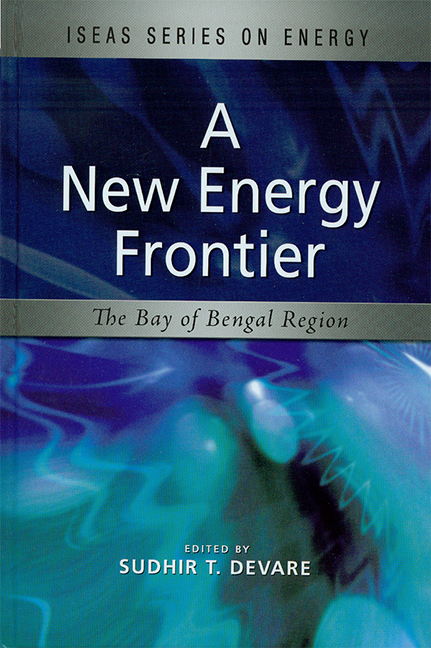Book contents
- Frontmatter
- Content
- Foreword
- Message from the Director
- Preface
- The Contributors
- 1 An Overview of the Energy Scene in the Bay of Bengal Region
- 2 Current and Expected Energy Production and Consumption within the Bay of Bengal Region: A Synopsis
- 3 Gas Potential at the Bay of Bengal and Implications for India's Energy Security
- 4 Macroeconomic Challenges for the Growth of the Energy Sector in Bangladesh in the Context of Regional Integration
- 5 Energy in the Bay of Bengal Region: Myanmar's Perspective
- 6 Marine-related Energy Resources in the Eastern Indian Ocean: Indonesian Perspective
- 7 Energy Trading and Singapore's Role as a Hub
- 8 Bay of Bengal: Awakening of a Potential Giant Area
- 9 Energy Transportation Security in the Bay of Bengal
- 10 Ethical Business Practice or Camouflage? Energy and Mining Companies and Corporate Social Responsibility
- 11 Sustainable and Renewable Energy: Scenarios for the Future
- Index
11 - Sustainable and Renewable Energy: Scenarios for the Future
Published online by Cambridge University Press: 21 October 2015
- Frontmatter
- Content
- Foreword
- Message from the Director
- Preface
- The Contributors
- 1 An Overview of the Energy Scene in the Bay of Bengal Region
- 2 Current and Expected Energy Production and Consumption within the Bay of Bengal Region: A Synopsis
- 3 Gas Potential at the Bay of Bengal and Implications for India's Energy Security
- 4 Macroeconomic Challenges for the Growth of the Energy Sector in Bangladesh in the Context of Regional Integration
- 5 Energy in the Bay of Bengal Region: Myanmar's Perspective
- 6 Marine-related Energy Resources in the Eastern Indian Ocean: Indonesian Perspective
- 7 Energy Trading and Singapore's Role as a Hub
- 8 Bay of Bengal: Awakening of a Potential Giant Area
- 9 Energy Transportation Security in the Bay of Bengal
- 10 Ethical Business Practice or Camouflage? Energy and Mining Companies and Corporate Social Responsibility
- 11 Sustainable and Renewable Energy: Scenarios for the Future
- Index
Summary
Renewables represent less than 2 per cent of the global power generation capacity — excluding large hydro, also known as “new renewables” — and are projected to reach a 6 per cent capacity by year 2030.
With average growth rates per year of more than 30 per cent for solar photovoltaic (PV) and over 20 per cent for wind power over the last five years, the renewable energy industry has come of age. As for bio-fuels, a recent report from McKinsey and Company concludes that much of the projected growth in industrial biotechnology — a US$77 billion industry in value within the chemical sector, counting products made from bio-based feed stocks or through fermentation or enzymatic conversion — is attributable to bio-fuels (ethanol and bio-diesel) as production is rapidly increasing to meet demand.
Conservative estimates show that, at the current rate of growth, the total renewables output (combined with biomass and bio-fuels) equivalent to only 2 per cent of the primary energy mix worldwide today, will at least double in the next twenty-five years.
Why is this Important to Us?
At the turn of the century, energy security has become the number one priority around the world. Every country is attempting to mitigate its reliance on limited and unstable primary energy sources. Due to the rapid economic growth of its two developing giants — China and India — and with a combined growth of more than 3.2 per cent per year — twice the world's average — the Asia-Pacific region surpasses the rest of the world in terms of energy demand. With half the projected global demand by year 2030, Asia- Pacific is central to this energy debate (source: Exxon Mobil tomorrow's energy report February 2006).
Will renewable energy shape the twenty-first century just like oil shaped the twentieth century world? The short answer is … not quite: to meet this formidable energy challenge, conventional energy sources, including large hydro and nuclear power will continue occupying a large share of our near-term landscape. Despite its rapid start, new renewable energy alternatives have a long way to go before reaching mainstream and making a significant contribution to our global energy mix. Fossil fuels (coal, oil and gas) will remain the dominant source of energy of the century.
- Type
- Chapter
- Information
- A New Energy FrontierThe Bay of Bengal Region, pp. 183 - 192Publisher: ISEAS–Yusof Ishak InstitutePrint publication year: 2008

